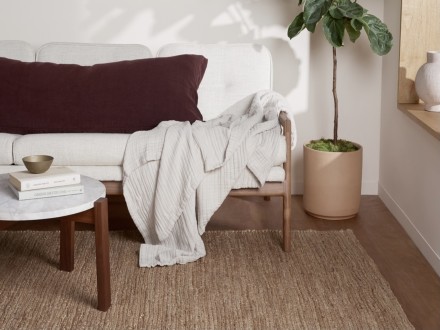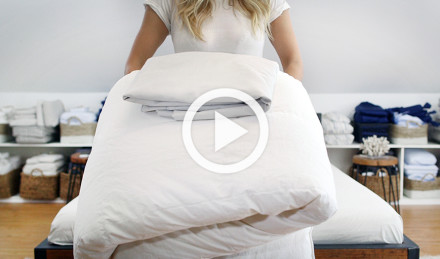Natural fiber rugs bring an organic vibe to any room while perfectly complementing many interior decor styles. Jute rugs in particular have proven very popular not just with the general public but also with design pros. The reason? They’re durable, easy to maintain, sustainable and highly cost-effective.
Widely available in multiple sizes and patterns, jute rugs make great living room accent pieces. Thanks to jute’s natural softness and sturdiness, you can also find these rugs in master and guest bedrooms, as well as dining rooms and kitchens.
Jute fabric’s natural, earthy hues make it the ideal foundation for any space during all four seasons. Jute material is the ultimate decor multitasker thanks to its airy, effortlessly-chic look.
Keep reading to find out more about jute, including where it comes from, how to clean it and how to use it wisely in your home decor.
What Is a Jute Rug?
Jute rugs are made from the jute plant (genus Corchorus), native to the tropical lowland areas of India and Bangladesh. Jute is actually the second most cultivated plant in the world after cotton. To create the fiber that’s then weaved into a rug, workers strip off the plant’s bark and then dry it. Jute is known as the “golden fiber” because of the distinct golden hue of the dried jute plants.
Undyed jute rugs have a shiny, light beige color that adds a beautiful texture and organic feel to any space. Despite its natural toughness and durability (a jute rug can last for years), jute rugs are known for being incredibly soft and breathable. In fact, the fabric is sometimes used to make sweaters and other clothing items.
Unlike synthetic rugs, the production of jute carpet is environmentally friendly (jute is biodegradable) and costs less, which is also reflected in the price of the final product. As a consequence, this versatile decor item has found its way into many hearts and households.
What Is a Jute Rug?
Jute rugs are made from the jute plant (genus Corchorus), native to the tropical lowland areas of India and Bangladesh. Jute is actually the second most cultivated plant in the world after cotton. To create the fiber that’s then weaved into a rug, workers strip off the plant’s bark and then dry it. Jute is known as the “golden fiber” because of the distinct golden hue of the dried jute plants.
Undyed jute rugs have a shiny, light beige color that adds a beautiful texture and organic feel to any space. Despite its natural toughness and durability (a jute rug can last for years), jute rugs are known for being incredibly soft and breathable. In fact, the fabric is sometimes used to make sweaters and other clothing items.
Unlike synthetic rugs, the production of jute carpet is environmentally friendly (jute is biodegradable) and costs less, which is also reflected in the price of the final product. As a consequence, this versatile decor item has found its way into many hearts and households.
Benefits of Jute Material
After jute plants are harvested, the stems are submerged in water for up to a month. This helps with the stripping process later, and makes the jute fabric very soft. Jute fibers have many uses in multiple industries such as home textiles, fashion, agriculture and even food, since jute can sometimes be used as an herb.
What makes this material a particularly good choice for rug production is its high tenacity, heat insulation properties, breathability and coarse texture that’s easy to clean. Jute rugs can be vacuum and spot cleaned. The fiber is easy to manipulate, so manufacturers offer jute rugs in an endless variety of colors, prints and sizes that fit every home aesthetic and taste.
The only downside of jute fabric is that humidity is its enemy. Because of this, jute rugs aren’t recommended in the bathroom or other high-humidity spaces.
Curious about other materials? See our Fabric and Bedding Materials Guide.
Benefits of Jute Material
After jute plants are harvested, the stems are submerged in water for up to a month. This helps with the stripping process later, and makes the jute fabric very soft. Jute fibers have many uses in multiple industries such as home textiles, fashion, agriculture and even food, since jute can sometimes be used as an herb.
What makes this material a particularly good choice for rug production is its high tenacity, heat insulation properties, breathability and coarse texture that’s easy to clean. Jute rugs can be vacuum and spot cleaned. The fiber is easy to manipulate, so manufacturers offer jute rugs in an endless variety of colors, prints and sizes that fit every home aesthetic and taste.
The only downside of jute fabric is that humidity is its enemy. Because of this, jute rugs aren’t recommended in the bathroom or other high-humidity spaces.
Curious about other materials? See our Fabric and Bedding Materials Guide.
Jute Rug Decor Ideas
Here’s a roundup of the easiest and most chic ways to incorporate the versatility of jute rugs into your house or apartment.
High-Traffic Area Multitasker
The natural strength of the jute fiber makes it the ideal option for high-traffic areas such as entryways, mudrooms, living rooms and kitchens. Another benefit to having a jute mat in your kitchen or dining room is that you can easily blot and clean it with soap and water even if you spill something on it while cooking or eating. There’s no need to spend a fortune on specialty cleaning services or dry cleaning. A good quality jute rug can last for years, even if it’s subjected to serious daily wear and tear.
Jute Rug Decor Ideas
Here’s a roundup of the easiest and most chic ways to incorporate the versatility of jute rugs into your house or apartment.
High-Traffic Area Multitasker
The natural strength of the jute fiber makes it the ideal option for high-traffic areas such as entryways, mudrooms, living rooms and kitchens. Another benefit to having a jute mat in your kitchen or dining room is that you can easily blot and clean it with soap and water even if you spill something on it while cooking or eating. There’s no need to spend a fortune on specialty cleaning services or dry cleaning. A good quality jute rug can last for years, even if it’s subjected to serious daily wear and tear.
Great Year-Round Option
Design pros often advise changing up your area rugs according to the season. One of the reasons is to switch to a weather-appropriate rug that feels airy in the summer, then another that feels soft and cozy in the winter. A soft jute rug is one of the few selections that can serve as both.
The organic look, breathability and natural color of jute create a lightness that’s perfect in the summertime and in warm climates. On the other hand, jute material’s softness and thickness feel great under your feet on colder days in winter, too.
Great Year-Round Option
Design pros often advise changing up your area rugs according to the season. One of the reasons is to switch to a weather-appropriate rug that feels airy in the summer, then another that feels soft and cozy in the winter. A soft jute rug is one of the few selections that can serve as both.
The organic look, breathability and natural color of jute create a lightness that’s perfect in the summertime and in warm climates. On the other hand, jute material’s softness and thickness feel great under your feet on colder days in winter, too.
Great for Layering
There’s a reason design pros can’t get enough of jute rugs. They can look casually cool in boho or rustic interiors, or elegant and sophisticated in traditional homes. That’s because their neutral, natural color provides a beautiful background to build on, creating a perfect foundation for style-specific pieces of furniture.
So whether you’re just dipping your toes into the complicated art of rug layering, or you’d like to add some texture to a room, a jute rug can do it all.
Popular Jute Rug Sizes
Jute rugs are very affordable. Even larger rugs won’t break the bank the way some synthetic or wool rugs do. Because of their budget-friendliness, manufacturers make them available in every possible size and shape.
A jute rug at 8x10 feet is popular for living rooms and dining rooms, while a 9x11 rug is large enough to fit under a king-size bed in a master bedroom.
Other popular sizes include 3x5 or 2x8 feet. Those sizes look wonderful in kitchens and entryways. Basically, no matter how unique, small or unusual your furniture setup or room is, there’s a jute rug to match.
Jute Rug Prints and Colors
While most design enthusiasts prefer to display jute rugs in their natural color — a very light brown or beige — they’re also available in many other shades and prints.
Ikat and Moroccan-inspired designs in jute can create a sophisticated boho look without stressing your budget. Abstract prints complement modern interiors well, while some monochromatic jute rugs are braided into geometric patterns such as chevron or stripes that add texture and interest to minimalist interiors.
One very popular jute rug design features an outside border and sometimes fringed edges. This is a nice fit for oversized rooms or lofts where rugs are used to define and frame a space and anchor its furniture.
Jute Rugs are a Guest Bedroom Decor Essential
Unlike master bedrooms, where you can personalize the look as much as you want, guest bedrooms need more general appeal. Since guest rooms are for hosting, it’s essential to decorate them with pieces that are neutral and easy to clean. A natural jute rug is also comfortable and stylish, lending a feel your visitors will appreciate. They’re also easy to maintain and look like new after a cleaning. Plus, they pair well with jute baskets — another guest bedroom and storage staple.
Need more guest bedroom decor ideas? See our article on How to Decorate a Guest Bedroom.
Jute Rugs as Wall Art
While this may not be an obvious choice, jute rugs are a gorgeous wall art option. Natural fibers, including jute, are easy to weave into different shapes, so some manufacturers offer jute mats that look like macrame wall hangings. These are hand-made by skilled artisans, and each is a unique, one-of-a-kind work of art. Jute wall hangings are available in floral-inspired and abstract designs and can create a focal point in a room or entryway and add personality to any space.
Great for Layering
There’s a reason design pros can’t get enough of jute rugs. They can look casually cool in boho or rustic interiors, or elegant and sophisticated in traditional homes. That’s because their neutral, natural color provides a beautiful background to build on, creating a perfect foundation for style-specific pieces of furniture.
So whether you’re just dipping your toes into the complicated art of rug layering, or you’d like to add some texture to a room, a jute rug can do it all.
Popular Jute Rug Sizes
Jute rugs are very affordable. Even larger rugs won’t break the bank the way some synthetic or wool rugs do. Because of their budget-friendliness, manufacturers make them available in every possible size and shape.
A jute rug at 8x10 feet is popular for living rooms and dining rooms, while a 9x11 rug is large enough to fit under a king-size bed in a master bedroom.
Other popular sizes include 3x5 or 2x8 feet. Those sizes look wonderful in kitchens and entryways. Basically, no matter how unique, small or unusual your furniture setup or room is, there’s a jute rug to match.
Jute Rug Prints and Colors
While most design enthusiasts prefer to display jute rugs in their natural color — a very light brown or beige — they’re also available in many other shades and prints.
Ikat and Moroccan-inspired designs in jute can create a sophisticated boho look without stressing your budget. Abstract prints complement modern interiors well, while some monochromatic jute rugs are braided into geometric patterns such as chevron or stripes that add texture and interest to minimalist interiors.
One very popular jute rug design features an outside border and sometimes fringed edges. This is a nice fit for oversized rooms or lofts where rugs are used to define and frame a space and anchor its furniture.
Jute Rugs are a Guest Bedroom Decor Essential
Unlike master bedrooms, where you can personalize the look as much as you want, guest bedrooms need more general appeal. Since guest rooms are for hosting, it’s essential to decorate them with pieces that are neutral and easy to clean. A natural jute rug is also comfortable and stylish, lending a feel your visitors will appreciate. They’re also easy to maintain and look like new after a cleaning. Plus, they pair well with jute baskets — another guest bedroom and storage staple.
Need more guest bedroom decor ideas? See our article on How to Decorate a Guest Bedroom.
Jute Rugs as Wall Art
While this may not be an obvious choice, jute rugs are a gorgeous wall art option. Natural fibers, including jute, are easy to weave into different shapes, so some manufacturers offer jute mats that look like macrame wall hangings. These are hand-made by skilled artisans, and each is a unique, one-of-a-kind work of art. Jute wall hangings are available in floral-inspired and abstract designs and can create a focal point in a room or entryway and add personality to any space.
How to Wash and Care for a Jute Rug
We already mentioned that one of the main reasons for the increasing popularity of jute rugs is that they’re easy to maintain in top shape. So how exactly should you care for your jute rug?
You can vacuum clean a jute rug up to twice a week using the lowest suction setting on your vacuum cleaner. Make sure to remove the beater bar and move the vacuum in the direction the fibers are woven.
Never steam clean or submerge your jute rug in water. However, you can use some water and mild soap (rug shampoo is a definite no-no) to spot-clean. Only dab the stain with a white cloth dipped in soapy water. Excessive moisture can lead to discoloration of the rug and will make it susceptible to mildew. A solution made from equal parts water and white vinegar will also do a great job of getting rid of a stain.
How to Wash and Care for a Jute Rug
We already mentioned that one of the main reasons for the increasing popularity of jute rugs is that they’re easy to maintain in top shape. So how exactly should you care for your jute rug?
You can vacuum clean a jute rug up to twice a week using the lowest suction setting on your vacuum cleaner. Make sure to remove the beater bar and move the vacuum in the direction the fibers are woven.
Never steam clean or submerge your jute rug in water. However, you can use some water and mild soap (rug shampoo is a definite no-no) to spot-clean. Only dab the stain with a white cloth dipped in soapy water. Excessive moisture can lead to discoloration of the rug and will make it susceptible to mildew. A solution made from equal parts water and white vinegar will also do a great job of getting rid of a stain.
Where to Shop for High-Quality Jute Carpet?
Rugs are such an essential part of home decor, and not just for practical reasons. They also tie together the look of the entire room. The beautiful natural jute rug designs you’ll find at Parachute come in several chic styles, hand-woven in India using 100% jute fibers in two earthy shades.
You’ll also discover a selection of wool and cotton area rugs at Parachute in geometric patterns and monochromatic color schemes. These pair well with any interior decor style, especially bohemian and modern, and will bring that luxurious magazine-worthy look to your home.
Where to Shop for High-Quality Jute Carpet?
Rugs are such an essential part of home decor, and not just for practical reasons. They also tie together the look of the entire room. The beautiful natural jute rug designs you’ll find at Parachute come in several chic styles, hand-woven in India using 100% jute fibers in two earthy shades.
You’ll also discover a selection of wool and cotton area rugs at Parachute in geometric patterns and monochromatic color schemes. These pair well with any interior decor style, especially bohemian and modern, and will bring that luxurious magazine-worthy look to your home.






